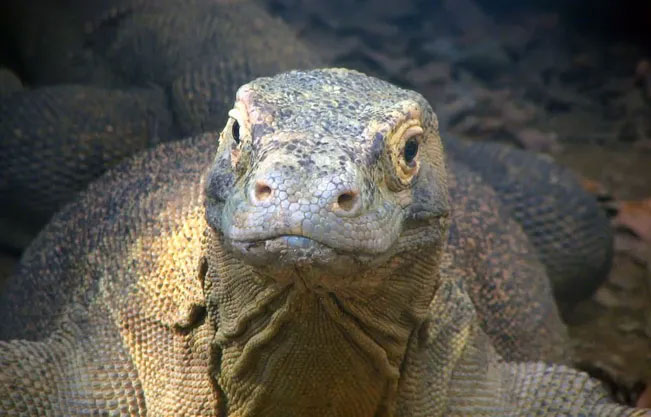These females do not need males to reproduce. The natural world is so strange!
The colorful animal world always makes us go from surprise to surprise, including that many animals can reproduce generations without the need for male sperm.

Komodo dragons can give birth without a male.
An Asian water dragon hatched from an egg at the Smithsonian National Zoo shocked many people. Although the female has never had sex with another male water dragon. Through genetic testing, scientists at the zoo discovered that newly hatched offspring were born through a reproductive method called parthenogenesis.
Parthenogenesis is a Greek word meaning "virgin" and it refers to the asexual reproduction of the female. Although many people associate this act of reproduction with science fiction or religion, the process of reproduction is surprisingly common in many living species, including plants, insects, fish, reptiles and even birds. Because mammals, including humans, require certain genes from sperm to form offspring. Mammals in particular are incapable of parthenogenesis.
Create a baby without sperm
Sexual reproduction involves a female and a male, each contributing genetic material in the form of eggs or sperm, to produce a single generation of offspring. Most animals reproduce sexually, but some species can produce eggs that contain all the genetic material needed for reproduction.
The offspring of these species, including some species of wasps, crustaceans and lizards reproduce only through parthenogenesis and are known as obligate reproductives.
A large number of species undergoing spontaneous parthenogenesis have been observed in zoo animals, such as the Asian water dragon at the US National Zoo or the blackhead shark at the Virginia Aquarium. .
Scientists already know spontaneous parthenogenesis can be a genetic trait, meaning that females who undergo parthenogenesis are more likely to be able to do the same later in their offspring. .
How can females self-fertilize their eggs?
For reproduction to occur, a sequence of cellular events must take place successfully. First, the female must be able to produce egg cells (oogenesis) without stimulation from sperm or through mating. Second, the eggs produced by the female need to begin to develop on their own, forming an early-stage embryo. In the end, the egg must hatch successfully.

In some cases, virginity can allow females to create their own sexual partners.
Each step of this process has a certain failure rate, especially step two which requires the chromosomes inside the egg to duplicate, ensuring adequate addition of genes for the developing offspring. Alternatively, eggs can be "falsely fertilized" by cells left over from egg production called polar bodies. Any method that kicks off the development of an embryo will determine the degree of genetic similarity between the mother and her offspring.
The events that trigger parturition are not fully understood, but it seems to include environmental change. In species that are capable of sexual reproduction and parthenogenesis, such as aphids, stressors such as crowding and predation can cause females to switch from parthenogenesis to sexual reproduction. Freshwater plankton, high salinity may be responsible for triggering this transition.
Advantages of self-reproduction
Although spontaneous parturition appears to be rare, it offers several benefits to the offspring. In some cases, it can allow females to create mates of their own.
The sex of the progeny is determined by the same method, the sex is determined within the species itself. In organisms where sex is determined by chromosomes, such as the XX female chromosome and the XY male chromosome in some insects, fish, and reptiles, a female can produce other offspring with only different infections. existing sex chromosomes, specifically that offspring will always produce offspring with an XX chromosome. But for organisms where the female has a ZW sex chromosome (such as in snakes and birds), all offspring will have a ZZ chromosome, i.e. males are predominant and rarer. is WW are children.
Between 1997 and 1999, a garter snake kept at the Phoenix Zoo gave birth to its last two males, and they are now living to adulthood. If a female mates with a male produced through parthenogenesis, it becomes inbreeding and leads to a host of genetic problems. But from an evolutionary perspective, this is better than not having any offspring left to mate with. The ability of females to produce a male through parthenogenesis suggests that asexual reproduction in the wild may be far more common than scientists previously imagined.

The sex of the hybrid progeny is determined by the same method.
For a long time, biologists have observed that obligate species often die from disease, parasites or changes in habitat. The inbreeding inherent in heterozygous species seems to have contributed to their short evolution.
The study of parthenogenesis aims to understand why some species can both mate and reproduce in order to survive and reproduce. It also answers the question of whether infrequent sexual reproduction is sufficient for a species to survive.
- The brains of males and females are not much different
- Why are female birds singing less and less?
- Males use prongs to mate females
- Birds also like the 'petition subject'
- Small males easily become meals for their children
- Sex games in the animal world
- Virgin mothers in the natural world
- Females live 18.6% longer than males on average.
- 'Western salary of women' in the ant world
- Contraceptives discharged through the toilet tube make males change their sex
- Strange males know to lay in the animal world
- Sand terns try to mate with the dead male
 Animal 'suffering' after hibernation
Animal 'suffering' after hibernation Why do goats climb well?
Why do goats climb well? Scientists were surprised to see chimpanzees eating turtles
Scientists were surprised to see chimpanzees eating turtles Giant catfish died deadly due to drought in Thailand
Giant catfish died deadly due to drought in Thailand